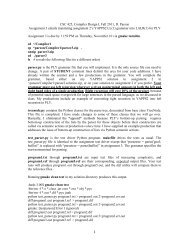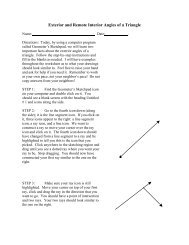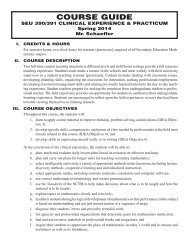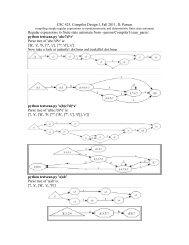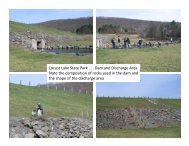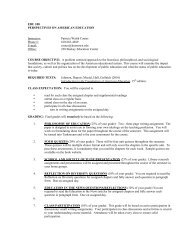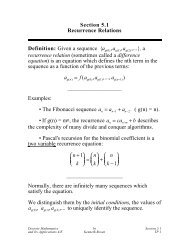Math 181 Syllabus - Faculty Home Pages
Math 181 Syllabus - Faculty Home Pages
Math 181 Syllabus - Faculty Home Pages
You also want an ePaper? Increase the reach of your titles
YUMPU automatically turns print PDFs into web optimized ePapers that Google loves.
<strong>Math</strong> <strong>181</strong> - Calculus I - <strong>Syllabus</strong> - Dr. Padraig McLoughlin - Spring of 2012Course ObjectivesCalculus IDr. M. P. M. M. McLoughlinSpring 2012Length of Course: One semester - meeting every day Monday through FridayPre-requisite: High School Algebra, Geometry, Trigonometry, and a satisfactory score on the<strong>Math</strong>ematics placement examination.Text (required):University Calculus: Elements with Early Transcendentals Haas, Weir, & Thomas, 1 st Edition.Pearson. ISBN: 9780321533487Machine (required):Calculators are banned in this class. The computer algebra system Maple or <strong>Math</strong>ematica maybe required for some take-home exercises or projects.Handouts, Worksheets, Open Questions, etc.(required to be downloaded each class):http://faculty.kutztown.edu/mcloughl/<strong>Math</strong><strong>181</strong>.htmlTexts (supplemental):The instructor may suggest supplemental exercises or reading from a number of sources; including,but not limited to:Calculus, Riddle (Any edition). Wadsworth.Calculus, Hunt (Any edition). Harper-Collins.Calculus, Grossman (Any edition). Harcourt.Schaum Outline Series: Calculus , Mendelson & Ayres (any edition). McGraw - Hill.Course Objective:This course is one of a series intended for students who major in mathematics, the sciences, or engineering.The topics include the definition and calculation of limits, continuity and differentiability,differentials, derivatives of algebraic and transcendental functions, the application of derivatives tographing, antiderivatives, the introduction of the definite integral, applications of definite integrals;and some techniques of integration. This course prepares students who major in mathematics, thesciences, or engineering with the mathematical background they need to address problems that arisein those majors. It could be counted in Category IV-A, IV-D, or V of General Education.1
2<strong>Math</strong> <strong>181</strong> - Calculus I - <strong>Syllabus</strong> - Dr. Padraig McLoughlin - Spring of 2012A student should have mastered and demonstrated the following skills after completing <strong>Math</strong> <strong>181</strong>:• the student is able to think logically• the student is able to reason and recognise patterns and be able to make conjectures• the student is able to use mathematical symbols• the student understands the basic concepts of analysis; limit, continuity and the derivative• the student is able to strike a judicious balance between theory and application, betweencomputational skills and mathematical sophistication and between intuition and rigour.• the student is able to do applications of derivatives.• the student is able to explain what a proof is and discern between a valid proof and claimthat a proof has been performed, but in reality has not.• the student is able to read a proof of a statement.• the student is able to construct a valid examples of true claims.• the student is able to construct valid counterexamples to propositions which are false.• the student is able to recognise and avoid common fallacies in arguments including beggingthe question, circular reasoning, affirming the conclusion, and denying the hypothesis.• the student is able to take a derivative by the definition of the derivative.• the student is able to take derivatives by the power, sum, product, quotient, or chain rule(and combinations of said).• the student is able to take derivatives by the polynomial, trigonometric, transcendental,algebraic, logarithmic, exponential, or rational functions (and combinations of said).• the student is able to find the area of a region in the plane using Riemann Sums.• the student understands the basic concepts and application of antidifferentiation.• the student understands the basic concepts and application of the definite integral.• the student understands the basic concepts and application of the Fundamental Theoremof Calculus.A brief overview of some (but not all of) the Course Content:R. A Brief 1 Review of Some Important Points From Pre-calculus1. The Real line and the Real plane 2. Algebra3. Functions 4. Graphs5. Trigonometry 6. Exponentials and LogarithmsA. Limits and Continuity1. Rates of Change and Tangents to Curves 2. Limit of a Function and Limit Laws3. Intuitive concept of limit 4. Precise Definition of a Limit5. One-Sided Limits 6. Continuity7. The squeeze theorem 8. Limits Involving ”Infinity”1 A Student can review throughout the semester. If the student does not know or remember any of the reviewmaterials and is not capable of self-review; then, that student should take <strong>Math</strong> 105, <strong>Math</strong> 106, or <strong>Math</strong> 115 before<strong>Math</strong> <strong>181</strong>. Too many people think that this is ’insulting.’ What is not helpful is to not know pre-requisite materialand fail this course 5 times or more rather than remediate and then succeed on a first try in <strong>Math</strong> <strong>181</strong> (I opine).
3<strong>Math</strong> <strong>181</strong> - Calculus I - <strong>Syllabus</strong> - Dr. Padraig McLoughlin - Spring of 2012A brief overview of some (but not all of) the Course Content (continued):B. Differentiation1. Tangents and Derivatives at a Point 2. The Derivative as a Function3. Differentiation Rules 4. The Derivative as a Rate of Change5. Derivatives of Trigonometric Functions 6. Derivatives of Exponential Functions7. The Chain Rule 8. Instantaneous velocity, speed, and acceleration9. Implicit Differentiation 10. Inverse Functions and Their Derivatives11. Derivatives of Logarithmic Functions 12. Derivatives of Inverse Trigonometric Functions13. Related Rates 14. Differentials and approximationsC. Applications of the Derivative1. Extreme Values of Functions 2. The Mean Value Theorem3. Monotonic Functions and the First Derivative Test4. Concavity, the Second Derivative Test, and Curve Sketching5. Applied Optimization 6. Indeterminate Forms and L’Hôpital’s Rule7. Hyperbolic Functions 8. Parameterizations of Plane Curves (optional)9. Newton’s Method (optional) 10. Antiderivatives and Differential EquationsD. Introduction to Integrals1. Antiderivatives and indefinite integration2. The definite integral 3. Change of variables4. Summation notation, Riemann Sums, and area 5. Properties of the definite integral6. The Fundamental Theorem of Calculus (FTC), Part I6. The Fundamental Theorem of Calculus (FTC), Part IIE. Applications of the Integrals1. Area between curves 2. Volume and density3. Solids of revolution: shells, discs, etc.4. Average value of a curve in the plane5. Arc length and surface areas6. Work, force, and pressure (optional) 7. Linear Differential EquationsOutline of the Course (with suggested pace):§ Title Sections Pace1I Preliminaries & Review of Pre-calculus Handouts & Worksheets2−1 weekII Limits and Continuity Chapter 1 2 1 2 weeksIII The Derivative Chapter 2 § 1 – 5 & 7 2 1 2 weeksIV Applications of the Derivative Chapter 3 2 1 2 weeksV The Anti-derivative and the Integral Chapter 4 2 1 2 weeksVI Applications of the Integral Chapter 6 3 1 2 weeks




